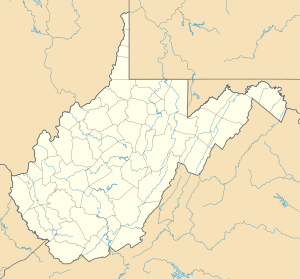Silver Bridge
Coordinates: 38 ° 50 ′ 42 " N , 82 ° 8 ′ 28" W.
| Silver Bridge | ||
|---|---|---|
| Official name | Ohio River Bridge | |
| use | Road bridge | |
| Crossing of | Ohio River | |
| place | Point Pleasant, West Virginia | |
| construction | Chain bridge | |
| overall length | 681 m | |
| Longest span | 213 m | |
| completion | 1928 | |
| closure | Collapse in 1967 | |
| location | ||
|
|
||
The Silver Bridge (officially Ohio River Bridge ) was a chain bridge over the Ohio River , which connected Point Pleasant , West Virginia , and Gallipolis , Ohio , from 1928 until it collapsed in 1967.
history
The General Corporation and the American Bridge Company constructed the two-lane suspension bridge , which was specified according to the specifications of the American Society of Civil Engineers . It was the first bridge of its kind in the USA. The 681 m long bridge was completed on May 30, 1928 and got its name because of the aluminum coating used for the first time .
Construction of the Silver Bridge
Carrying chains
The suspension chains of the Silver Bridge consisted of connected tension rods, so-called eye rods , which were connected to each other by bolts at their closed eyes . At the time of completion, this type of execution had already been successfully implemented for 100 years. Until then, such bridges had always been designed with four to sixfold redundancy , as was the case with the English Clifton Suspension Bridge of 1864 designed by Isambard Kingdom Brunel . This very old suspension bridge is still used and proves the constructive reliability of such bridges.
The support chains of the Silver Bridge were only made with two rods made of heat-treated case-hardened steel , which had twice the tensile strength of ordinary steels. The breakage of one of the rods can lead to sudden overloading of the other rod. In the case of suspension chains with low redundancy, safety is therefore highly dependent on the flawless manufacture and assembly of the components.
Buttresses
The pylons were designed as 40 m high oscillating piers that were not rigidly connected to the foundation at their base. This enabled the bridge to cushion load changes, vibrations and temperature fluctuations without overloading the suspension chains. As a result, the two pylons needed the suspension chains on both sides as support, which is why a break in one of the suspension chains led to the failure of the entire bridge.
Load assumption
At the time of construction, a typical family car like the Ford Model T weighed around 680 kg. The maximum permissible total weight of a truck was approximately 9,000 kg. Forty years later, at the time of the bridge collapse, the vehicle weight of a brand-new Ford Mustang was already twice as much, namely 1,400 kg, and large American trucks weighed up to 27,000 kg. The traffic density had also multiplied during the period.
collapse
On December 15, 1967 at 5:04 p.m. the Silver Bridge collapsed. Because of the heavy rush hour traffic, 37 vehicles were on the bridge at the time of the accident, 31 of which crashed into the Ohio River. 46 people died and nine were seriously injured.
Accident analysis
The four-year investigation into the rubble named a crack on the tie rod 330 due to an undiscovered manufacturing defect as the cause of the disaster. A minor structural defect caused the eye stick to fail due to corrosion and material fatigue.
Consequential effect
In response to the disaster, President Lyndon B. Johnson ordered a nationwide review of all bridges for operational safety. 1800 bridges were currently over 40 years old, of which 1100 were still specified for the load of a Ford Model-T. The collapse of the Silver Bridge led to improved material tests, logged regular inspections and ultimately to the demolition of some older bridges.
The construction of the Silver Memorial Bridge was announced on February 8, 1968 by Lyndon B. Johnson and was completed exactly two years after the accident on December 15, 1969.
The collapse of the bridge was linked to appearances of the legendary figure Mothman , recorded by journalist John A. Keel in his 1975 book The Mothman Prophecies . The 2002 film The Mothman Prophecies is based on them .
Web links
- The Collapse of the Silver Bridge by Chris LeRose in West Virginia Historical Society Quarterly (vol. Xv, No. 4, October 2001) (English)
- Silver Bridge. In: Structurae


